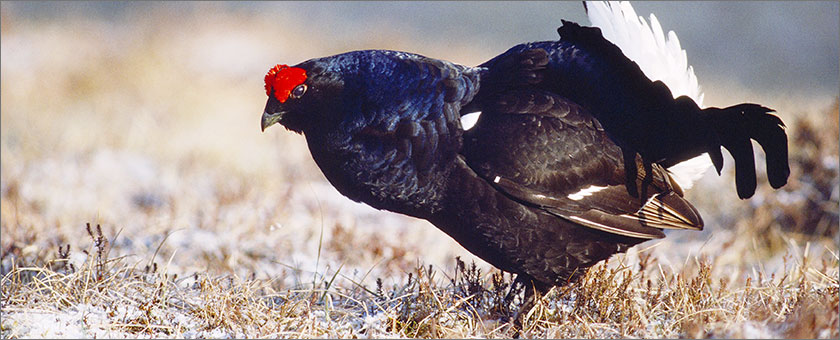ScottishPower Renewables leading the way in habitat management at windfarms across Scotland
ScottishPower Renewables (SPR), one of the world’s leading wind energy developers, is developing innovative research to protect black grouse on its windfarms across Scotland.
As part of its commitment to habitat restoration and environmental stewardship, SPR is undertaking management work for the benefit of black grouse across a number of its sites in Scotland in an effort to help prevent the species’ rapid decline.
SPR has a dedicated ecology team which oversees the habitat management and monitoring across all of its windfarms. At sites including Cruach Mhor in Argyll and Bute and Green Knowes in Perthshire the team has overseen the creation of native woodland habitats, involving planting trees and the restoration of moorland areas.

SPR also plans to undertake a detailed study which will track the movements of black grouse in relation to windfarms, following on from a collaborative study with Newcastle University with funding support from the World Pheasant Association (WPA). This project will look into the impact the presence of a windfarm has upon local black grouse populations.
The collaboration of SPR ecologists and researchers are working on a plan which will enable them to ‘tag’ black grouse by fitting them with harnesses carrying data loggers. This information will allow the ecologists to build a detailed picture of the birds’ movements. The SPR windfarm at Cruach Mhor on the Cowal Peninsula, Argyll and Bute, will be the first trial site for this project as the area is known to have one of the highest black grouse populations across SPR’s windfarms and in the whole Cowal area.
A motion sensor camera has been installed on site to identify areas commonly used by grouse for lekking (mating) or feeding. Once this has been identified, a trap will be set up and a qualified and licenced harness fitter will attach the tags. Data will then be collected as the grouse move around the site, and will be remotely downloaded at regular intervals for analysis and reporting.
By examining this data, the team will be able to study the impact of windfarms on black grouse. SPR best practice ensures that turbines are not built closer than 500m to a black grouse lekking area, and this research project, along with the research carried out by Newcastle University, will help to understand how black grouse use the landscape around a windfarm.
A wide variety of native species have benefitted from SPR’s continued habitat management projects, notably including golden eagles at the Beinn an Tuirc site in Argyll. An extensive Habitat Management Plan covering an area of 1680 hectares (a hectare is typically the same size as a sports field) has been managed for the benefit of the eagles. This has included the restoration of heather moorland from commercial conifer plantation to boost the numbers of prey, including red grouse. Since 2008 the eagles have fledged six chicks, making them one of the most productive pairs in Argyll in recent years.

Between 2010 and 2012, SPR also provided £5,000 per annum to RSPB Scotland towards the funding of a specialist Black Grouse Officer, and the research work SPR is currently undertaking marks a continuation in the company’s sustained ecological efforts.
Senior Ecologist at ScottishPower Renewables, Peter Robson, said: “ScottishPower Renewables has a number of challenges when considering the viability of a windfarm. First and foremost for any application there are rigorous ecological assessments that we carry out. We are dedicated to habitat preservation and restoration, across many different ecological and topographical settings, and work closely with partners such as RSPB Scotland and Scottish Natural Heritage to ensure that we are working to support the environment and eco-system at all sites.
“This commitment by SPR has led to some very exciting research projects for the ecology team. This innovative black grouse project will allow us to understand more fully the impact of windfarms on the black grouse population. As responsible developers of renewable energy, we are keen to do everything in our power to protect this important and secretive species and this pioneering research will help inform those decisions.”
Doug Shapley of RSPB Scotland, said: “We welcome this new study by ScottishPower Renewables and Newcastle University. Black grouse are a red list species meaning they are of the highest conservation priority in the UK.
“Numbers have declined throughout Argyll and this is one of the few areas of Cowal where black grouse still occur, albeit at a lower population level. Habitat management is really important to helping these birds and we’re interested to see what the tagging might reveal about how they use the landscape at these sites.”
Notes to Editors
ScottishPower Renewables is part of Iberdrola, the world’s largest wind energy developer, with an operating portfolio of over 14,000 megawatts (MW). ScottishPower Renewables is responsible for progressing Iberdrola’s onshore wind and marine energy projects in the UK and offshore windfarms throughout the world.
Securing our position at the forefront of the renewable energy industry, ScottishPower Renewables now has 30 operational windfarm sites producing over 1,600 MW, including West of Duddon Sands, our first offshore windfarm project. With a further 500 MW of onshore windfarm projects due to be constructed, we are set to maintain our position as the UK's leading wind developer.
With our 350 MW Wikinger Offshore Windfarm in the German Baltic Sea due to be constructed in 2017 and our East Anglia ONE windfarm, which has full planning consent and a contract that will allow us to develop up to 700 MW, we are set to position Iberdrola as the world's leading offshore wind developer.
The World Pheasant Association (WPA) in September celebrates 40 years of International Conservation work on the Worlds Gamebirds which include the Grouse family. It set up and ran The First International Woodland Grouse Symposium in Scotland (Culloden Hotel , Invernessshire) in 1978. In 1982/83 it funded a Ph.d project into the requirements of Black Grouse chicks for survival.